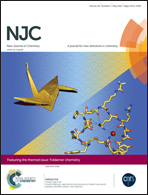Investigation of the electrical conductivity and optical property of polyaniline-based nanocomposite and its application as an ethanol vapor sensor
Abstract
Polyaniline–Sn(IV)iodophosphate (PANI–SnIP) nanocomposite cation exchanger was synthesized via the sol–gel approach and its AC and DC electrical conductivity, dielectric properties and optical properties were studied. The characterization of the nanocomposite using FT-IR, UV-Vis spectroscopy, SEM and TEM showed the formation of a nanocomposite with improved physicochemical properties. The AC electrical conductivity was found to increase with the increase in applied frequency and concentration of the Sn(IV)iodophosphate (SnIP) filler content. The optical band gap of the nanocomposite decreased from 3.99 eV for pure polyaniline (PANI) to 3.60 eV for the nanocomposite with 30% SnIP content. The ethanol vapor sensing characteristics were evaluated by the fabrication of a PANI–SnIP nanocomposite as a sensor for ethanol vapor detection. The sensing performance of the nanocomposite was markedly improved with the increase of SnIP concentration. The nanocomposite sensor exhibited a linear response to the variable concentration of ethanol (50, 100, 300, and 500 ppm), a quick response time, and a reproducible and reversible response, which are a clear manifestation of its sensing ability and environmental utility.


 Please wait while we load your content...
Please wait while we load your content...